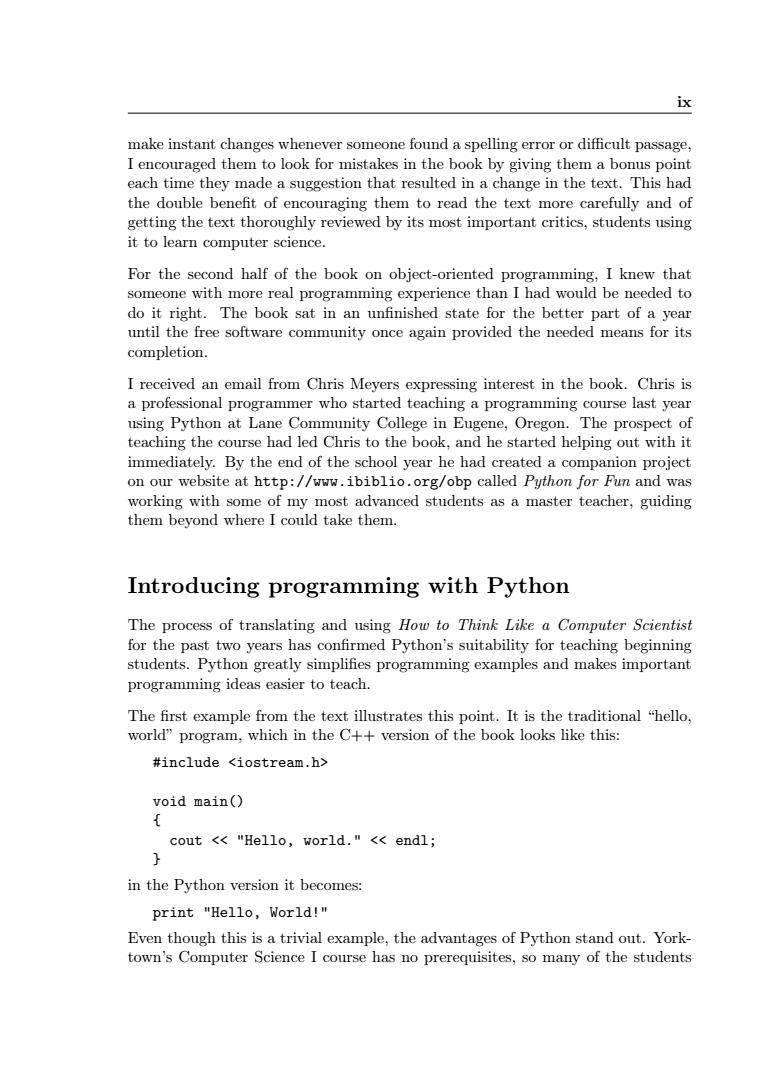正在加载图片...

i议 make instant changes whenever someone found a spelling error or difficult passage, I encouraged them to look for mistakes in the book by giving them a bonus point each time they made a suggestion that resulted in a change in the text.This had the double benefit of encouraging them to read the text more carefully and of getting the text thoroughly reviewed by its most important critics,students using it to learn computer science. For the second half of the book on object-oriented programming,I knew that someone with more real programming experience than I had would be needed to do it right.The book sat in an unfinished state for the better part of a year until the free software community once again provided the needed means for its completion. I received an email from Chris Meyers expressing interest in the book.Chris is a professional programmer who started teaching a programming course last year using Python at Lane Community College in Eugene,Oregon.The prospect of teaching the course had led Chris to the book,and he started helping out with it immediately.By the end of the school year he had created a companion project on our website at http://www.ibiblio.org/obp called Python for Fun and was working with some of my most advanced students as a master teacher,guiding them beyond where I could take them. Introducing programming with Python The process of translating and using How to Think Like a Computer Scientist for the past two years has confirmed Python's suitability for teaching beginning students.Python greatly simplifies programming examples and makes important programming ideas easier to teach. The first example from the text illustrates this point.It is the traditional "hello, world"program,which in the C++version of the book looks like this: #include <iostream.h> void main() f cout <"Hello,world."<<endl; in the Python version it becomes: print"Hello,World!" Even though this is a trivial example,the advantages of Python stand out.York- town's Computer Science I course has no prerequisites,so many of the studentsix make instant changes whenever someone found a spelling error or difficult passage, I encouraged them to look for mistakes in the book by giving them a bonus point each time they made a suggestion that resulted in a change in the text. This had the double benefit of encouraging them to read the text more carefully and of getting the text thoroughly reviewed by its most important critics, students using it to learn computer science. For the second half of the book on object-oriented programming, I knew that someone with more real programming experience than I had would be needed to do it right. The book sat in an unfinished state for the better part of a year until the free software community once again provided the needed means for its completion. I received an email from Chris Meyers expressing interest in the book. Chris is a professional programmer who started teaching a programming course last year using Python at Lane Community College in Eugene, Oregon. The prospect of teaching the course had led Chris to the book, and he started helping out with it immediately. By the end of the school year he had created a companion project on our website at http://www.ibiblio.org/obp called Python for Fun and was working with some of my most advanced students as a master teacher, guiding them beyond where I could take them. Introducing programming with Python The process of translating and using How to Think Like a Computer Scientist for the past two years has confirmed Python’s suitability for teaching beginning students. Python greatly simplifies programming examples and makes important programming ideas easier to teach. The first example from the text illustrates this point. It is the traditional “hello, world” program, which in the C++ version of the book looks like this: #include <iostream.h> void main() { cout << "Hello, world." << endl; } in the Python version it becomes: print "Hello, World!" Even though this is a trivial example, the advantages of Python stand out. Yorktown’s Computer Science I course has no prerequisites, so many of the students